
Baffle spray scrubber
Encyclopedia

Spray tower
Spray towers or spray chambers are a form of pollution control technology. They consist of empty cylindrical vessels made of steel or plastic and nozzles that spray liquid into the vessels. The inlet gas stream usually enters the bottom of the tower and moves upward, while liquid is sprayed...
s in design and operation. However, in addition to using the energy provided by the spray nozzles, baffle
Baffle
Baffle or baffles may refer to:* Baffle , a flow-directing vane or panel in some vessels such as shell and tube heat exchangers, chemical reactors, or static mixers...
s are added to allow the gas stream to atomize some liquid as it passes over them.
A simple baffle scrubber system is shown in Figure 1. Liquid sprays capture pollutant
Pollutant
A pollutant is a waste material that pollutes air, water or soil, and is the cause of pollution.Three factors determine the severity of a pollutant: its chemical nature, its concentration and its persistence. Some pollutants are biodegradable and therefore will not persist in the environment in the...
s and also remove collected particles from the baffles. Adding baffles slightly increases the pressure drop
Pressure drop
Pressure drop is a term used to describe the decrease in pressure from one point in a pipe or tube to another point downstream. "Pressure drop" is the result of frictional forces on the fluid as it flows through the tube. The frictional forces are caused by a resistance to flow. The main...
of the system.
This type of technology is a part of the group of air pollution
Air pollution
Air pollution is the introduction of chemicals, particulate matter, or biological materials that cause harm or discomfort to humans or other living organisms, or cause damage to the natural environment or built environment, into the atmosphere....
controls collectively referred to as wet scrubber
Wet scrubber
The term wet scrubber describes a variety of devices that remove pollutants from a furnace flue gas or from other gas streams. In a wet scrubber, the polluted gas stream is brought into contact with the scrubbing liquid, by spraying it with the liquid, by forcing it through a pool of liquid, or by...
s.
A number of wet-scrubber designs use energy from both the gas stream and liquid stream to collect pollutants. Many of these combination devices are available commercially.
A seemingly unending number of scrubber designs have been developed by changing system geometry and incorporating vanes, nozzles, and baffles.
Particle collection
These devices are used much the same as spray towerSpray tower
Spray towers or spray chambers are a form of pollution control technology. They consist of empty cylindrical vessels made of steel or plastic and nozzles that spray liquid into the vessels. The inlet gas stream usually enters the bottom of the tower and moves upward, while liquid is sprayed...
s - to preclean or remove particles larger than 10 μm in diameter. However, they will tend to plug or corrode if particle concentration of the exhaust gas stream is high.
Gas collection
Even though these devices are not specifically used for gas collection, they are capable of a small amount of gas absorption because of their large wetted surface.Summary
These devices are most commonly used as precleaners to remove large particles (>10 μm in diameter). The pressure dropPressure drop
Pressure drop is a term used to describe the decrease in pressure from one point in a pipe or tube to another point downstream. "Pressure drop" is the result of frictional forces on the fluid as it flows through the tube. The frictional forces are caused by a resistance to flow. The main...
s across baffle scrubbers are usually low, but so are the collection efficiencies. Maintenance problems are minimal. The main problem is the buildup of solids on the baffles.
Table 1 summarizes the operating characteristics of baffle spray scrubbers.
| Table 1. Operating characteristics of baffle spray scrubbers | |||||
|---|---|---|---|---|---|
| Pollutant | Pressure drop (Δp) | Liquid-to-gas ratio (L/G) | Liquid-inlet pressure (pL) | Removal efficiency | Applications |
| Gases | 2.5-7.5 cm of water | 0.13 l/m3 (1 gal/1,000 ft3) | < 100 kPa (< 15 psig) | very low | Mining operations Incineration Chemical process industry |
| Particles | 1-3 in of water | 10 µm diameter | |||

